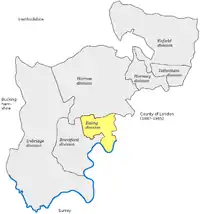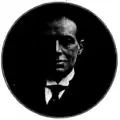| Ealing | |
|---|---|
| Former Borough constituency for the House of Commons | |
 Ealing 1885–1918 | |
 Ealing 1918–1945 | |
| 1885–1945 | |
| Seats | one |
| Created from | Middlesex |
| Replaced by | Ealing East |
| During its existence contributed to new seat(s) of: | Brentford and Chiswick; Acton |
Ealing was a parliamentary constituency centred on the Ealing district of west London. It returned one Member of Parliament (MP) to the House of Commons of the UK Parliament, 1885–1945. In common with metropolitan areas the seat saw major population increase. Until 1918 it included Chiswick, Acton within the County of London, and part of Hanwell in the rump of dwindling Middlesex.
Boundaries
- 1885–1918: The civil parishes of Ealing, Acton, Greenford, Chiswick and Perivale and part of that of Hanwell.
- 1918–1945: The Municipal Borough of Ealing (as it stood in 1918, being Ealing, ignoring 1926 succession to the former urban districts of Greenford (including the parishes of Perivale and West Twyford) and Hanwell).
History
The constituency was created by the Redistribution of Seats Act 1885 for the 1885 general election, and abolished for the 1945 general election. It was then replaced by the new Ealing East and Ealing West constituencies.
Members of Parliament
| Election | Member | Party | |
|---|---|---|---|
| 1885 | Lord George Hamilton | Conservative | |
| 1906 | Sir Herbert Nield | Conservative | |
| 1931 | Sir Frank Sanderson | Conservative | |
| 1945 | constituency abolished | ||
Elections
Elections in the 1880s

| Party | Candidate | Votes | % | ±% | |
|---|---|---|---|---|---|
| Conservative | George Hamilton | 4,353 | 61.8 | ||
| Liberal | William Bruce Gordon Hogg | 2,691 | 38.2 | ||
| Majority | 1,662 | 23.6 | |||
| Turnout | 7,044 | 75.9 | |||
| Registered electors | 9,283 | ||||
| Conservative win (new seat) | |||||
| Party | Candidate | Votes | % | ±% | |
|---|---|---|---|---|---|
| Conservative | George Hamilton | Unopposed | |||
| Conservative hold | |||||
Hamilton was appointed First Lord of the Admiralty, causing a by-election.
| Party | Candidate | Votes | % | ±% | |
|---|---|---|---|---|---|
| Conservative | George Hamilton | Unopposed | |||
| Conservative hold | |||||
Elections in the 1890s
| Party | Candidate | Votes | % | ±% | |
|---|---|---|---|---|---|
| Conservative | George Hamilton | 5,547 | 72.4 | N/A | |
| Liberal | Stephen Holman | 2,112 | 27.6 | New | |
| Majority | 3,435 | 44.8 | N/A | ||
| Turnout | 7,659 | 63.4 | N/A | ||
| Registered electors | 12,081 | ||||
| Conservative hold | |||||
Hamilton is appointed Secretary of State for India, requiring a by-election.
| Party | Candidate | Votes | % | ±% | |
|---|---|---|---|---|---|
| Conservative | George Hamilton | Unopposed | |||
| Conservative hold | |||||
| Party | Candidate | Votes | % | ±% | |
|---|---|---|---|---|---|
| Conservative | George Hamilton | Unopposed | |||
| Conservative hold | |||||
Elections in the 1900s
| Party | Candidate | Votes | % | ±% | |
|---|---|---|---|---|---|
| Conservative | George Hamilton | Unopposed | |||
| Conservative hold | |||||

| Party | Candidate | Votes | % | ±% | |
|---|---|---|---|---|---|
| Conservative | Herbert Nield | 8,261 | 54.2 | N/A | |
| Liberal | Arthur Hill Hutton | 6,982 | 45.8 | New | |
| Majority | 1,279 | 8.4 | N/A | ||
| Turnout | 15,243 | 74.6 | N/A | ||
| Registered electors | 20,436 | ||||
| Conservative hold | |||||
Elections in the 1910s
| Party | Candidate | Votes | % | ±% | |
|---|---|---|---|---|---|
| Conservative | Herbert Nield | 12,916 | 61.1 | +6.9 | |
| Liberal | Maurice Charles Hulbert | 8,210 | 38.9 | -6.9 | |
| Majority | 4,706 | 22.2 | +13.8 | ||
| Turnout | 21,126 | 84.3 | +9.7 | ||
| Conservative hold | Swing | +6.9 | |||
| Party | Candidate | Votes | % | ±% | |
|---|---|---|---|---|---|
| Conservative | Herbert Nield | Unopposed | |||
| Conservative hold | |||||
General election 1914–15:
Another general election was required to take place before the end of 1915. The political parties had been making preparations for an election to take place and by the July 1914, the following candidates had been selected;
- Unionist: Herbert Nield
- Liberal:
| Party | Candidate | Votes | % | ±% | |
|---|---|---|---|---|---|
| Unionist | Herbert Nield | Unopposed | |||
| Unionist hold | |||||
| Party | Candidate | Votes | % | ±% | |
|---|---|---|---|---|---|
| C | Unionist | Herbert Nield | 13,710 | 79.2 | N/A |
| Labour | Alfred Chilton | 3,610 | 20.8 | New | |
| Majority | 10,100 | 58.4 | N/A | ||
| Turnout | 17,320 | 60.4 | N/A | ||
| Unionist hold | |||||
| C indicates candidate endorsed by the coalition government. | |||||
Elections in the 1920s
| Party | Candidate | Votes | % | ±% | |
|---|---|---|---|---|---|
| Unionist | Herbert Nield | 14,507 | 67.9 | -11.3 | |
| Labour | Alfred Chilton | 6,128 | 28.7 | +7.9 | |
| Ind. Unionist | Lewis Hall | 719 | 3.4 | New | |
| Majority | 8,379 | 39.2 | -19.2 | ||
| Turnout | 21,354 | 65.8 | +5.4 | ||
| Unionist hold | Swing | -9.6 | |||
| Party | Candidate | Votes | % | ±% | |
|---|---|---|---|---|---|
| Unionist | Herbert Nield | 12,349 | 53.1 | -14.8 | |
| Liberal | Alfred William Bradford | 6,410 | 27.6 | New | |
| Labour | Alfred Chilton | 4,495 | 19.3 | -9.4 | |
| Majority | 5,939 | 25.5 | -13.7 | ||
| Turnout | 23,254 | 69.0 | +3.2 | ||
| Unionist hold | Swing | N/A | |||
| Party | Candidate | Votes | % | ±% | |
|---|---|---|---|---|---|
| Unionist | Herbert Nield | 18,572 | 73.3 | +20.2 | |
| Labour | Alfred Chilton | 6,765 | 26.7 | +7.4 | |
| Majority | 11,807 | 46.6 | +21.1 | ||
| Turnout | 25,337 | 73.2 | +4.2 | ||
| Unionist hold | Swing | +6.4 | |||
| Party | Candidate | Votes | % | ±% | |
|---|---|---|---|---|---|
| Unionist | Herbert Nield | 20,503 | 54.4 | -18.9 | |
| Labour | James William Maycock | 9,093 | 24.2 | -2.5 | |
| Liberal | Arrean Paul Grundy | 8,042 | 21.4 | New | |
| Majority | 11,410 | 30.2 | -16.4 | ||
| Turnout | 37,638 | 73.4 | +1.2 | ||
| Unionist hold | Swing | -8.2 | |||
Elections in the 1930s
| Party | Candidate | Votes | % | ±% | |
|---|---|---|---|---|---|
| Conservative | Frank Sanderson | 32,792 | 82.7 | +28.3 | |
| Labour | James William Maycock | 6,857 | 17.3 | -6.9 | |
| Majority | 25,935 | 65.4 | +35.2 | ||
| Turnout | 39,649 | 74.6 | +1.2 | ||
| Conservative hold | Swing | +17.6 | |||
| Party | Candidate | Votes | % | ±% | |
|---|---|---|---|---|---|
| Conservative | Frank Sanderson | 28,472 | 74.1 | -8.6 | |
| Labour | Mark Auliff | 9,972 | 25.9 | +8.6 | |
| Majority | 18,500 | 48.2 | -17.2 | ||
| Turnout | 38,444 | 69.1 | -5.5 | ||
| Conservative hold | Swing | -8.6 | |||
General election 1939–40
Another general election was required to take place before the end of 1940. The political parties had been making preparations for an election to take place and by the Autumn of 1939, the following candidates had been selected;
- Conservative: Frank Sanderson
- Labour: D. J. Johnston[7]
References
- 1 2 3 4 5 6 7 8 9 10 11 British Parliamentary Election Results 1885–1918, F. W. S. Craig
- 1 2 3 4 5 6 7 The Liberal Year Book, 1907
- ↑ Debrett's House of Commons & Judicial Bench, 1886
- 1 2 Debrett's House of Commons & Judicial Bench, 1901
- 1 2 Debrett's House of Commons & Judicial Bench, 1916
- 1 2 3 4 5 6 7 British Parliamentary Election Results 1918-1949, FWS Craig
- ↑ Report of the Annual Conference of the Labour Party, 1939